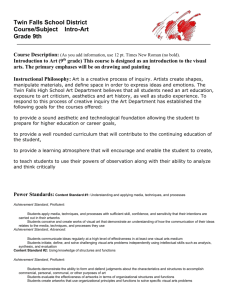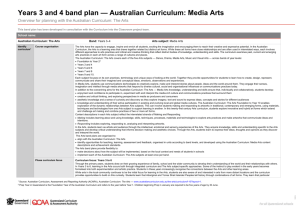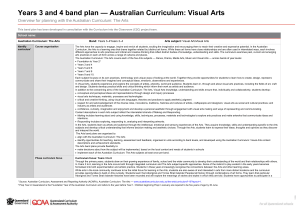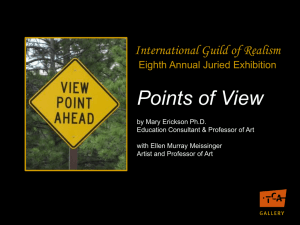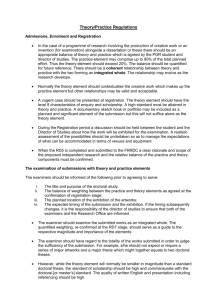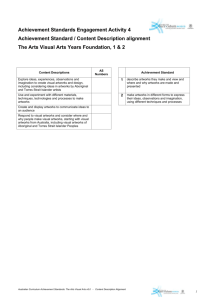Years 5 and 6 band plan * Australian Curriculum: Media Arts
advertisement
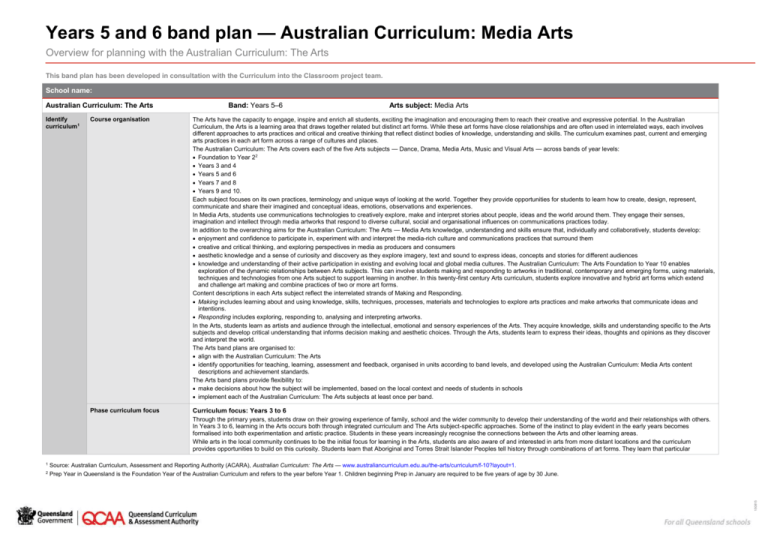
Years 5 and 6 band plan — Australian Curriculum: Media Arts Overview for planning with the Australian Curriculum: The Arts This band plan has been developed in consultation with the Curriculum into the Classroom project team. School name: Identify curriculum1 Band: Years 5–6 Arts subject: Media Arts Course organisation The Arts have the capacity to engage, inspire and enrich all students, exciting the imagination and encouraging them to reach their creative and expressive potential. In the Australian Curriculum, the Arts is a learning area that draws together related but distinct art forms. While these art forms have close relationships and are often used in interrelated ways, each involves different approaches to arts practices and critical and creative thinking that reflect distinct bodies of knowledge, understanding and skills. The curriculum examines past, current and emerging arts practices in each art form across a range of cultures and places. The Australian Curriculum: The Arts covers each of the five Arts subjects — Dance, Drama, Media Arts, Music and Visual Arts — across bands of year levels: Foundation to Year 22 Years 3 and 4 Years 5 and 6 Years 7 and 8 Years 9 and 10. Each subject focuses on its own practices, terminology and unique ways of looking at the world. Together they provide opportunities for students to learn how to create, design, represent, communicate and share their imagined and conceptual ideas, emotions, observations and experiences. In Media Arts, students use communications technologies to creatively explore, make and interpret stories about people, ideas and the world around them. They engage their senses, imagination and intellect through media artworks that respond to diverse cultural, social and organisational influences on communications practices today. In addition to the overarching aims for the Australian Curriculum: The Arts — Media Arts knowledge, understanding and skills ensure that, individually and collaboratively, students develop: enjoyment and confidence to participate in, experiment with and interpret the media-rich culture and communications practices that surround them creative and critical thinking, and exploring perspectives in media as producers and consumers aesthetic knowledge and a sense of curiosity and discovery as they explore imagery, text and sound to express ideas, concepts and stories for different audiences knowledge and understanding of their active participation in existing and evolving local and global media cultures. The Australian Curriculum: The Arts Foundation to Year 10 enables exploration of the dynamic relationships between Arts subjects. This can involve students making and responding to artworks in traditional, contemporary and emerging forms, using materials, techniques and technologies from one Arts subject to support learning in another. In this twenty-first century Arts curriculum, students explore innovative and hybrid art forms which extend and challenge art making and combine practices of two or more art forms. Content descriptions in each Arts subject reflect the interrelated strands of Making and Responding. Making includes learning about and using knowledge, skills, techniques, processes, materials and technologies to explore arts practices and make artworks that communicate ideas and intentions. Responding includes exploring, responding to, analysing and interpreting artworks. In the Arts, students learn as artists and audience through the intellectual, emotional and sensory experiences of the Arts. They acquire knowledge, skills and understanding specific to the Arts subjects and develop critical understanding that informs decision making and aesthetic choices. Through the Arts, students learn to express their ideas, thoughts and opinions as they discover and interpret the world. The Arts band plans are organised to: align with the Australian Curriculum: The Arts identify opportunities for teaching, learning, assessment and feedback, organised in units according to band levels, and developed using the Australian Curriculum: Media Arts content descriptions and achievement standards. The Arts band plans provide flexibility to: make decisions about how the subject will be implemented, based on the local context and needs of students in schools implement each of the Australian Curriculum: The Arts subjects at least once per band. Phase curriculum focus Curriculum focus: Years 3 to 6 Through the primary years, students draw on their growing experience of family, school and the wider community to develop their understanding of the world and their relationships with others. In Years 3 to 6, learning in the Arts occurs both through integrated curriculum and The Arts subject-specific approaches. Some of the instinct to play evident in the early years becomes formalised into both experimentation and artistic practice. Students in these years increasingly recognise the connections between the Arts and other learning areas. While arts in the local community continues to be the initial focus for learning in the Arts, students are also aware of and interested in arts from more distant locations and the curriculum provides opportunities to build on this curiosity. Students learn that Aboriginal and Torres Strait Islander Peoples tell history through combinations of art forms. They learn that particular 1 Source: Australian Curriculum, Assessment and Reporting Authority (ACARA), Australian Curriculum: The Arts — www.australiancurriculum.edu.au/the-arts/curriculum/f-10?layout=1. 2 Prep Year in Queensland is the Foundation Year of the Australian Curriculum and refers to the year before Year 1. Children beginning Prep in January are required to be five years of age by 30 June. 150815 Australian Curriculum: The Arts Aboriginal and Torres Strait Islander histories have been recorded and will explore the meanings of stories and styles in which they are told. Students have opportunities to participate in a variety of Aboriginal and Torres Strait Islander art forms that are publicly available for broader participation in their community. Students may also extend their cultural expression with appropriate community consultation and endorsement. Students also study artworks which represent Australia’s connections with other places, the effects of these interconnections and the factors that affect people’s knowledge and opinions of other places. During these years of schooling, students’ thought processes become more logical and consistent, and they gradually become more independent as learners. Students talk about changes in their own thinking, performance or making, giving reasons for their actions and explaining and demonstrating their organisation of ideas. They begin to recognise, appreciate and value the different ways in which others think, act and respond to artworks and consider how practices in the Arts may be enacted and sustained. Teaching and learning Band description In Years 5 and 6, learning in Media Arts builds on the experience of the previous band. It involves students making and responding to media arts independently, and collaboratively with their classmates, teachers and communities. Students develop their use of structure, intent, character and settings by incorporating points of view and genre conventions in their compositions. They explore and use time, space, sound, movement, lighting and technologies. They identify the variety of audiences for which media artworks are made. They explain the purpose and processes for producing media artworks. As they experience media arts, students draw on media arts from a range of cultures, times and locations. They explore the media arts and influences of Aboriginal and Torres Strait Islander Peoples, and those of the Asia region. Students learn about media arts in and beyond their local community. Students explore how representation, characteristics and points of view of Aboriginal and Torres Strait Islander Peoples can be presented in media artworks. As they make and respond to media artworks, students explore meaning and interpretation, and forms and elements including structure, intent, character and settings. They explore the social, cultural and historical contexts of media arts. They evaluate the use of elements of media in media artworks they view and present. Students maintain safety in use of technologies and in interaction with others, including the use of images and works of others. They consider the ethical behaviour and role of communities and organisations in regulating access to media artworks. Their understanding of the roles of artists and audiences builds upon previous bands as students engage with more diverse media artworks. Achievement standard By the end of Year 6, students explain how points of view, ideas and stories are shaped and portrayed in media artworks they make, share and view. They explain the purposes and audiences for media artworks made in different cultures, times and places. Students work collaboratively using technologies to make media artworks for specific audiences and purposes using story principles to shape points of view and genre conventions, movement and lighting. Content descriptions For each unit: Explore representations, characterisations and points of view of people in their community, including themselves, using settings, ideas, story principles and genre conventions in images, sounds and text (ACAMAM062) Develop skills with media technologies to shape space, time, movement and lighting within images, sounds and text (ACAMAM063) Plan, produce and present media artworks for specific audiences and purposes using responsible media practice (ACAMAM064) Explain how the elements of media arts and story principles communicate meaning by comparing media artworks from different social, cultural and historical contexts, including Aboriginal and Torres Strait Islander media artworks (ACAMAR065) Viewpoints3 The Australian Curriculum: The Arts outlines a range of viewpoints — a collection of perspectives, lenses or frames through which artworks can be explored and interpreted. These perspectives, lenses and frames include the contexts, knowledge and evaluations students consider when both making and responding to artworks. Media Arts enables students to create and communicate representations of diverse worlds and investigate the impact and influence of media artworks on those worlds, both individually and collaboratively. As an art form evolving in the twenty-first century, Media Arts enables students to use existing and emerging technologies as they explore imagery, text and sound and create meaning as they participate in, experiment with and interpret diverse cultures and communications practices. In both Making and Responding, students learn that meanings can be generated from different viewpoints and that these shift according to different world encounters. As students make, investigate or critique media artworks as producers and consumers of media arts, they may ask and answer questions to interrogate the producers’ meanings and the consumers’ interpretations. Meanings and interpretations are informed by contexts of societies, cultures and histories, and an understanding of how elements, materials, skills and processes are used. These questions provide the basis for making informed critical judgments about their own media artworks and the media artworks they see, hear, interact with and consume as audiences. The complexity and sophistication of such questions will change across Foundation to Year 10. In the later years, students will consider the interests and concerns of artists and audiences regarding philosophies and ideologies, critical theories, institutions and psychology. Key questions: Years 5 and 6 Context as artist and audience: What did the artist want the audience to see and understand about the community? How do the social, cultural and historical contexts of media artists influence their representations of community? What similarities and differences are evident in media artworks from different social, cultural and historical contexts? 3 Knowledge as artist and audience: How have images, sounds and text been presented for a specific audience and purpose? How does the media artist use media technologies to shape space, time, movement and lighting? How does the choice of media languages and genre conventions communicate the media artist’s intentions? Evaluations and judgments as artist and audience: How have responsible media practices been considered in the representations, characterisations and points of view depicted in the media artwork? What decisions did the media artists make to enhance meaning for specific audiences? How does the media artist express their point of view? Source: Australian Curriculum, Assessment and Reporting Authority (ACARA), Australian Curriculum: The Arts — Media Arts: Rationale and Learning in Media Arts, www.australiancurriculum.edu.au/the-arts/media-arts/rationale. Years 5 and 6 band plan — Australian Curriculum: Media Arts Overview for planning with the Australian Curriculum: The Arts Queensland Curriculum & Assessment Authority October 2015 Page 2 of 3 Unit overviews The Australian Curriculum assumes that all students will study the five Arts subjects from Foundation to the end of Year 6. Schools decide which units of study per subject to complete, and how and when. This band plan provides three potential units. General capabilities Cross-curriculum priorities Unit 1 — Light and shadow Unit 2 — Documentaries Unit 3 — Reality TV Students shape time and space to explore representations in media art forms. Students will: explore how media artists control form, light and shadow to suggest ideas and a point of view about an aspect of their community experiment with media technology and collaborative production processes (film, photography, editing, lighting, video and special effects, sound and text) to create an aesthetic media arts production present productions in digital form to share and discuss similarities and differences in story principles, point of view, genre conventions, movement and lighting explain how the elements of media arts and story principles communicate meaning through comparison of media artworks from Australia, including media artworks of Aboriginal peoples and Torres Strait Islander peoples. This unit could complement the concepts taught in the Year 5 Science unit Now you see it in the Science exemplar Year plan by exploring form, light and shadow in film and photography. See: www.qcaa.qld.edu.au/downloads/p_10/ac_ science_yr5_plan.docx. Students create a documentary-style film to tell the personal story of someone known to them or researched. Students will: explore the use of documentary codes and conventions to tell a story, depict a character, enhance representation and point of view experiment with media technology and collaborative production processes (script, storyboard, film, photography, editing, lighting, sound and text) to create mood and atmosphere and communicate point of view present productions in digital form to share and discuss similarities and differences in story principles, point of view, genre conventions, mood and lighting compare and explain the shaping of viewpoint, ideas and stories in their own media artwork and that of others, examining representation of culture, time and place in media artworks from Australia, including media artworks of Aboriginal peoples and Torres Strait Islander peoples. This unit could complement the concepts taught in the Year 6 History unit Investigating the emergence of Australia as a diverse nation in the History exemplar Year plan by exploring and presenting stories of people from their community who add to the diversity. See: www.qcaa.qld.edu.au/downloads/ aust_curric/ac_yr6_history_year_plan.docx. Students explore reality television concepts and production processes from ideation to creation. Students will: explore representations and characterisations of people in reality television programming and how point of view is controlled by creators of reality television through story principles and genre conventions experiment with production of reality television concepts based on school community and student audience, considering how point of view can be controlled by production and use of media technologies present productions in digital form to share and discuss similarities and differences in story principles, point of view, genre conventions and use of media technologies compare and explain the shaping of viewpoint, ideas and stories in their own media artwork and that of others, examining representation of character, time and place in media artworks from Australia, including media artworks of Aboriginal peoples and Torres Strait Islander peoples. Literacy Numeracy ICT capability Critical and creative thinking Personal and social capability Intercultural understanding Ethical understanding Aboriginal and Torres Strait Islander histories and cultures Develop assessment Assessment The Year 3 to Year 6 The Arts: Australian Curriculum in Queensland — assessment and reporting advice and guidelines brings together advice about assessment, making judgments and reporting in a single document: www.qcaa.qld.edu.au/downloads/p _10/ac_arts_yr3-6.pdf. The assessment for each unit provides evidence of student learning and provides opportunities for teachers to make judgments about whether students have met the Australian Curriculum: Media Arts Years 5 and 6 achievement standard. Students should contribute to an individual assessment folio that provides evidence of their learning and represents their achievements. The folio should include a range and balance of assessments for teachers to make valid judgments about whether the student has met the achievement standard. It will gather evidence of their ability to: explain how points of view, ideas and stories are shaped and portrayed in media artworks they make and share explain how points of view, ideas and stories are shaped and portrayed in media artworks they view explain the purposes and audiences for media artworks made in different cultures, times and places work collaboratively using technologies to make media artworks for specific audiences and purposes using story principles to shape points of view and genre conventions, movements and lighting. Make judgments and use feedback Consistency of teacher judgments Make judgments of student achievements using the relevant achievement standards and task-specific standards. Identify opportunities to moderate samples of student work at a school or cluster level to reach consensus and consistency. Make consistent and comparable judgments by matching characteristics of the student work and qualities in the achievement standards. Years 5 and 6 band plan — Australian Curriculum: Media Arts Overview for planning with the Australian Curriculum: The Arts Queensland Curriculum & Assessment Authority October 2015 Page 3 of 3
